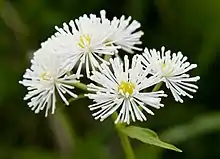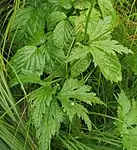Trautvetteria
Trautvetteria is a genus of flowering plants in the buttercup family. Today it is often considered a monotypic genus, containing only one species, Trautvetteria caroliniensis,[1] which is known by the common names Carolina bugbane,[2] false bugbane, and tassel-rue. A second species, T. japonica, is now generally considered a variety of this species.[3] The genus is named for the botanist Ernst Rudolf von Trautvetter.[1]
| Trautvetteria | |
|---|---|
 | |
| Scientific classification | |
| Kingdom: | |
| (unranked): | |
| (unranked): | |
| Order: | |
| Family: | |
| Genus: | Trautvetteria |
| Species: | T. caroliniensis |
| Binomial name | |
| Trautvetteria caroliniensis (Walter) Vail | |
This plant is native to Asia and eastern and western North America. It grows in moist wooded areas and other habitat. It is a rhizomatous perennial herb producing an erect stem up to 1.5 meters in maximum height. The large leaf has a palmate blade up to 30 or 40 centimeters wide with deeply divided, pointed, toothed lobes. The blade is borne on a long, slender petiole which may measure up to 45 centimeters long. The leaf is green, darker on top and paler underneath. The inflorescence is a panicle with several clusters of flowers on branches. The flower has no petals and is mostly made up of many long, white stamens each up to a centimeter long. At the center is a spherical cluster of green pistils. This develops into a spherical cluster of green fruits.
The plant contains protoanemonin, which may cause blistering or skin irritation.[4]
 Stem leaves are deeply lobed (background leaves are Rubus)
Stem leaves are deeply lobed (background leaves are Rubus)
| Wikimedia Commons has media related to Trautvetteria caroliniensis. |
References
- Flora of North America: Trautvetteria
- "Trautvetteria caroliniensis". Natural Resources Conservation Service PLANTS Database. USDA. Retrieved 14 December 2015.
- Flora of North America: T. caroliniensis
- Fagan, Damian (2019). Wildflowers of Oregon: A Field Guide to Over 400 Wildflowers, Trees, and Shrubs of the Coast, Cascades, and High Desert. Guilford, CT: FalconGuides. p. 79. ISBN 1-4930-3633-5. OCLC 1073035766.
External links